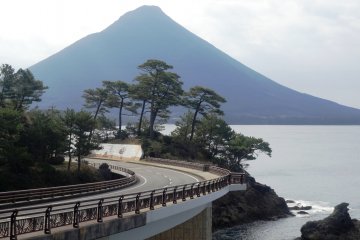Kagoshima was once Satsuma, led by the Shimazu Clan (1603-1867). It played a pivotal role in the Meiji Restoration (1868-1912). Leading figures of the Restoration were "Kagoshima boys", Shimazu samurai, heroes and martyrs, who with others from elsewhere, triggered Japan's modernization. You can walk to learn about this significant period at both Kagoshimachuo and Kagoshima.
The Museum of the Meiji Restoration is a good start to the Kagoshimachuo segment. It is a high tech narrative of events and protagonists in Japan's engagement with the West between 1603-1867. Saigo Takamori, the main initiator and leader of change, with his comrades, feature prominently.
The walk along the adjacent Kotsuki River is serene scenery with history.

Highlights are interactive screens that relay detailed information, and 47 stone pillars inscribed with Satsuma's ancient history. A stone monument commemorates the birthplace of Saigo Takamori. An original thatched house is an example of where he lived.
The Kagoshimachuo walk can be regarded as the inception of the fight to eradicate feudalism. Both the Museum and walk, for example, include the Goji system of education that instilled the mindsets that brought about the dynamic changes. At Kagoshimachuo Station, there's a statue of the young men sent to the UK to study how technology would benefit Japan. They look all hopeful and full of dreams, reaching and climbing upwards.

The Kagoshima segment might be seen as where it all ended. It mainly revolves around the Satsuma Rebellion of 1877. It arose when Takamori felt Japan was becoming too modern too fast, and the roots of its character, the samurai spirit, was dissolving. They lost badly, and Takamori's last stand as samurai and statesman was on Shiroyama Hill. The cave where Takamori hid and died tragically, is a cavernous black hole.

It's a wonderful forested walk up Shiroyama Hill, with an observatory and a lonely jizo shrine. Follow the path by the side of the Reimeikan, Kagoshima's history museum. Bullet-hole ridden walls of the school where Saigo trained his samurai can be seen on the grounds. You need to look closely, though.
Following a steep uphill road, is Nanshu Park. It's a wooded hill adorned by a shrine dedicated to Saigo Takamori, and Nanshu Cemetery, where Takamori and 2,023 comrades are buried. Small sake bottles and fresh flowers indicate they are not forgotten.

A bright white building in contrast with the brooding mausoleum, is the Saigo Nanshu Memorial Museum built in 1977 to commemorate the 100th anniversary of Takamori's death. How time passes.
No getting away from this aspect of Kagoshima's history. Especially at Kagoshima, there are statues, monuments, signboards, historic heaps of stones, galore. Statues stand on road corners with informative plaques.

A mound of rubble turns out to be from the mansion garden of a great general, Saigo Judo. On Sakuramajima, at the bus stop, a signboard declares it to be the Yokoyama battle site memorial. A British ship, the Perseus, engaged in battle with the Satsumas. You don't need any formal route. Just walk about. Follow the road signages. It can be a poignant looking and learning, even for a visitor.














